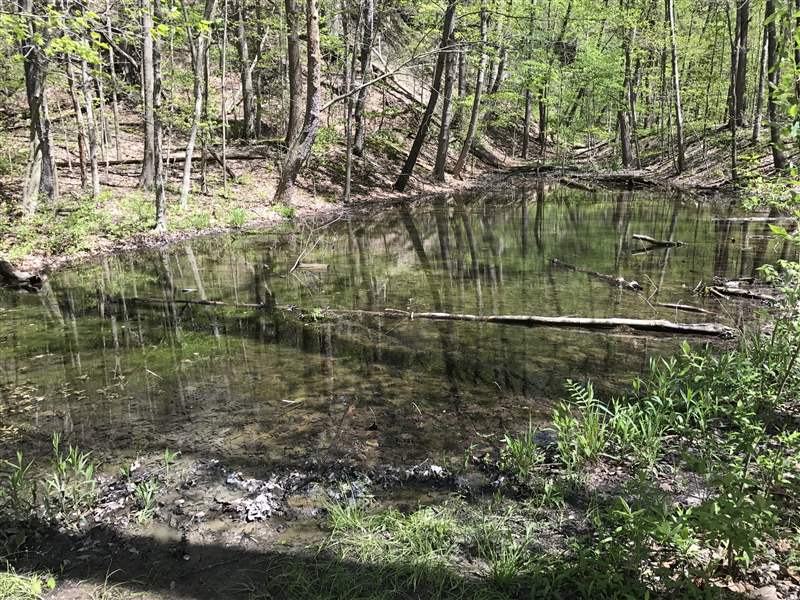
OUTDOORS
Heavy rains start the cycle of life in seasonal ponds
6/18/2018
Vernal or seasonal pools in fields or woodlots provide essential breeding habitat for certain species, such as toads, frogs and salamanders.
The Blade/Matt Markey
Buy This Image
DUNBRIDGE, Ohio — The corners and low spots in the fields spread out in every direction like an agricultural quilt wrapped around this tiny village have held water many days throughout spring and early summer. The numerous wood lots nearby also have often been a spongy, soggy mess, with leaf litter-lined pools everywhere you look.
But these impromptu natural aquariums are much more than puddles or mini swamps. Charged and fed by the semi-frequent heavy rains of the past few months, these often shallow and wide seasonal ponds are nature’s nursery for certain species.
Called vernal pools since they are most often a phenomenon of spring, these watery depressions are the scene of mating, emerging life, and predator and prey struggles. Everything occurs at a rapid pace, since the sand is slipping through the hourglass as sun and wind evaporate the pool. More rain sustains the sequence of life, while no rain accelerates the demise of the pool’s dwellers.
VIDEO: An American Toad calls from a vernal pool
One low spot in the far corner of a northern Wood County field recently held about six inches of water following a series of passing rain-maker storms. In less than 24 hours after the rain pooled in this location, the seasonal pond was full of American toads ready to use the mini swamp as their breeding grounds. Their chirping started just as the sun went down, and reached a crescendo once darkness fell.
The choir kept it up into the night, with the song of these tiny amphibians carrying across the landscape. It seemed like less than a week later, this wet area was down to about three inches in depth, and loaded with squirming tadpoles.
“Those little black tadpoles in the flooded farm fields are indeed toad larvae,” said Greg Lipps, a biologist at Ohio State University, and the Amphibian & Reptile Conservation Coordinator for the Ohio Biodiversity Conservation Partnership.
Lipps said that besides salamanders, both the American toad and the Fowler’s toad will use vernal pools in the area for breeding and hatching the next generation. Toads and frogs will travel considerable distances to take advantage of seasonal ponding areas, he added.
“Gray tree frogs also readily use these flooded fields for breeding,” Lipps said, adding that he heard a chorus of these small, arboreal frogs that are native to much of the eastern United States and southeastern Canada singing from a flooded field near his central Ohio home recently. “I also recall coming across a large breeding congregation of Gray tree frogs one night in a farm field in Seneca County, where the nearest stand of trees was about a half mile away.”
Lipps said these temporary pools of water in farm fields and woodlots are also utilized by the Eastern spadefoot toad, Ohio’s only toad on the endangered species list. This critter gets its name from the spade-like projections on its hind feet that enable it to quickly dig into the soil by rocking back and forth. This toad burrows into the ground during dry periods, emerging after heavy rains with its tell-tale call that sounds much like a crow.
The OSU biologist said that once the tadpoles emerge in these season pools, the race is on to advance to adulthood when the toad will no longer need the watery surroundings. Most don’t complete their development.
“I'm often asked about rescuing tadpoles from drying pools,” Lipps said. “The truth is, the majority of tadpoles don't survive in these pools, and if they did we would be swimming in toads. But in years where the rains come at the right times and in the right amounts, we can have real banner years of recruitment. So while the pools are a gamble for toads that doesn't pay off in most years, when conditions are right they can exploit the resources of these pools to make lots and lots of babies.”
The fact that these vernal ponds are temporary gives the toads the opportunity to develop, Lipps added, since there is no “well-established community of predators” inhabiting these pools. He said the minimal competition for food and space, plus the fact that predators such as fish can’t survive in these seasonal waters, makes the vernal pools so valuable to amphibians.
The OSU biologist also pointed out that these toads and their tadpoles play a vital role in nutrient cycling by feeding on the algae and rotting plants present in these seasonal pools of water.
“Regardless of whether they complete metamorphosis and take those nutrients with them, or they die and decompose back into the soil, they are trapping and cycling nutrients,” he said. “When drain tiles are installed to rid the water in these fields, it also means that the nutrients that would be consumed by the tadpoles are now going into our ditches, and eventually into Lake Erie.”
Contact Blade outdoors editor Matt Markey at: mmarkey@theblade.com or 419-724-6068.